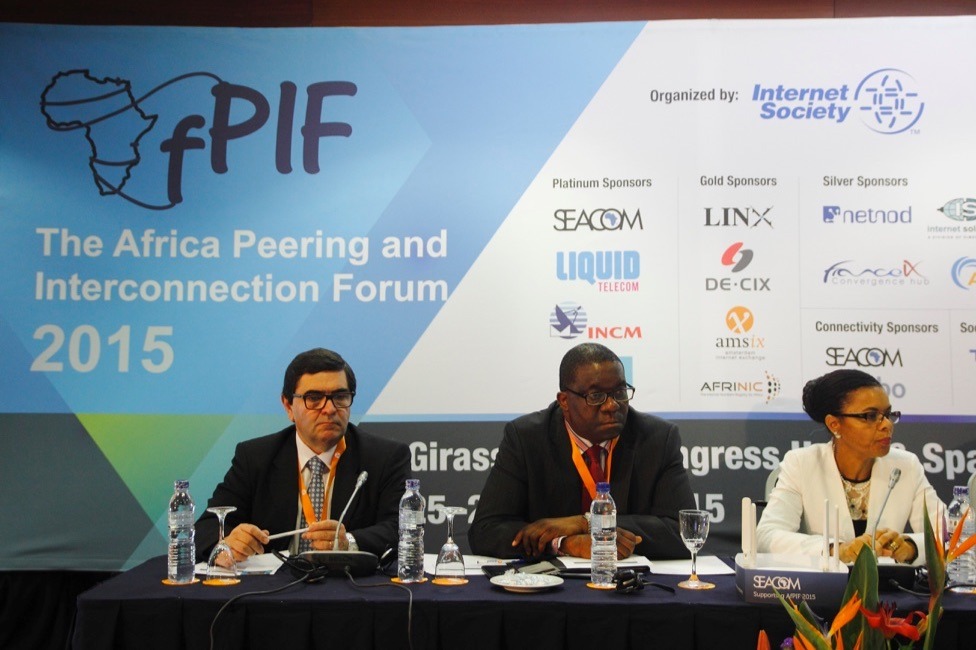Working with Local Partners
We started day two at the African Peering and Interconnection Forum (AfPIF) with the opening ceremony, attended by leaders from Mozambique’s government, education sector, and the private sector. Mozambique’s team is really helping make a difference by opening up the market, supporting the IXP, and working on innovative University projects.
Raul Echeberria, VP, Global Engagement at the Internet Society, gave the opening address; underscoring the importance of training and partnerships, if Africa is to achieve its technology goals.
“The Internet Society has trained more than 1,000 engineers and held more than 75 IXP related workshops in Africa; Internet penetration has grown from seven percent in 2008 to 20 percent today, this is good progress but we still have 80 percent to go,” Echeberria said.
In his speech, Prof. Orland Quilambo, Rector, Eduardo Mondlane University (UEM) underscored the role the university has played in ICT infrastructure growth in Mozambique, from bringing Internet into the country, to facilitating the set up of the first IXP.
Dr. Ema Chicoco, CEO, Instituto Nacional das Comunicaçoes de Moçambique (INCM) highlighted the crucial role the regulator has played in ensuring network growth to remote areas, through the universal access fund. She added that the regulator recognises that ICT infrastructure develops fast and there is a need to encourage business models that grow the economy.
Prof. Venancio Massingue, Internet Community Representative and CEO, Science Innovation and Information and Communication Technology Research Institute (SIITRI) is considered the father of the Internet in Mozambique. Prof. Massingue reminisced his attendance of the INET event in San Jose, California in 1998 and the opportunities the training exposed them to. He highlighted the need for increased research within countries, training youth, and knowledge sharing.
Dr. Manuela Rebelo, Vice Minister, Ministry of Transport and Communications formally opened the event, with a commitment that Mozambique will continue with infrastructure growth. She said that the country was also in the process of the digital TV migration, which will open-up more spectrum for infrastructure and ICT business avenues.
Highlights
The highlight of the day was a panel discussing lessons learnt over the last six years of AfPIF. The Serekunda IXP in Gambia, one of the IXPs that came up under the AXIS project, had the opportunity to share their one-year experience. Launched in July 2014, the IXP has seven peers, and already is in discussions with Google and Akamai to host their caches,.
Lessons Learnt from Growing African Cloud Services
- Setting up the IXP is the easy part for the tech community.. Running it and making it attractive to peers is what has proved to be more challenging than expected.
- Proving an IXPs value to bigger networks when starting out..
This presentation prompted the question whether countries with limited local content should bother setting up IXPs or should wait for local content to increase. The response was that the best approach is to set up, because there is no way of telling the reaction from the market.
- Liquid Telecom shared how it took them 10 years to get to 72% local content (54% Africa peering + 18% CDN), and;
- Teraco shared how one client was able to reduce their transit costs by 40 per cent, just by peering at NAPAfrica, and
To demonstrate how peering can reduce costs across sectors, Teraco shared how the South African banking market has been able to save R8 million (US$ 800,000) just by peering at NAPAfrica.
Angani Limited, one of Kenya’s cloud services providers, shared their experience in attracting local businesses to their network. The company was started last year, and currently serves leading email and hosting providers in Kenya, bus companies running ticketing applications, e-health apps and media content. “Uptime” is critical and redundancy helps. Angani collocates at two data centres and is currently pushing 40 Mbps of Internet traffic to KIXP.
- Affordable pricing, redundancy, security and reliability are key.
- Peering at KIXP has allowed Angani to provide free local capacity, allowing media companies to back up and archive content easily.
Most Popular Tweet of the day
Why the Internet matters to Africa https://t.co/euiNekZUaT #AfPIF2015 #Ghana
— AfPIF (@AfPIF) August 26, 2015

